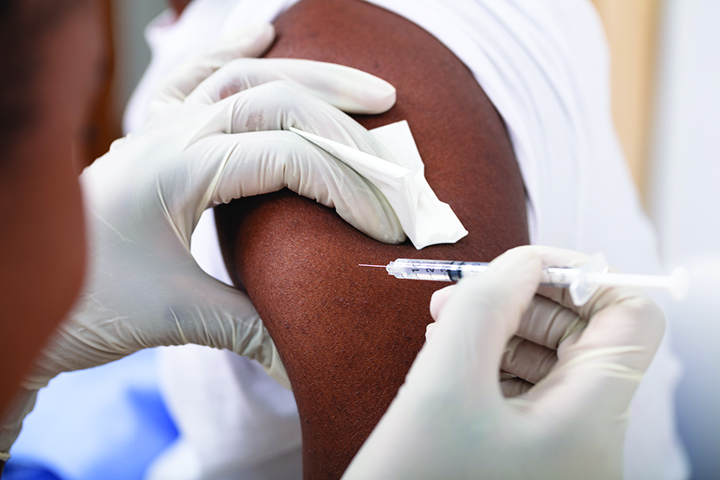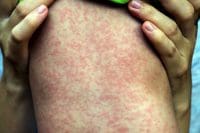The American Community Survey reported over 50 million people in the United States are age 65 years and older, with 55.7% of these individuals being female.1 Over 92% of older adults reported having a wellness visit in the past year.2 Nurse practitioners (NPs) who provide primary care for older women can use wellness and sick visits as an opportunity to discuss preventive healthcare and vaccinations with their patients. Lack of vaccine recommendations by healthcare providers has been linked to low vaccine utilization by patients.3 Nurse practitioners should assess each woman’s need for vaccinations based on her current health status, past medical history, and the benefits and risks of vaccination. It is significant for NPs to understand the indications and benefits of immunizations for older women and recommend the appropriate vaccines needed to help women maintain their health as they age.
Understanding how vaccinations work
Vaccinations work by introducing the body’s immune system to a fragment of a specific organism. This exposure triggers the immune system to form antibodies to fight against the organism. Through the process of exposure to the organism in vaccines, the body develops the ability to kill or fight off the organism if exposed later, also known as an immune response.4 Beyond protecting individuals, vaccinations can have a great impact on communities. As more individuals in a community become vaccinated against an organism, the organism is less likely to spread because of the number in the community who have immunity to the specific organism.4
Recommended immunizations
The Centers for Disease Control and Prevention (CDC) currently recommends four vaccines for adults age 65 years and older as part of the adult immunization schedule.5 These vaccines include influenza; tetanus, diphtheria, and pertussis; zoster; and pneumococcal.5 In addition to the regular immunization schedule, the Advisory Council on Immunization Practices (ACIP) recommends administration of the Covid-19 vaccines for older adults.5 Vaccine recommendations will vary based on the individual.
Influenza
Seasonal influenza (flu) is a contagious viral respiratory illness seen each year. Influenza presents most often in the fall and winter months, with the peak occurring in February.6 It is commonly caused by human influenza A and B viruses and was associated with more than 16.5 million medical visits during the 2018–2019 flu season.7 Adults age 65 years and older and those who are immunocompromised are at high risk of complications from the flu such as pneumonia, myocarditis, and even multi-organ failure.7 Due to multiple strands of the flu virus causing the seasonal flu and the number of people affected by the flu each year, the annual influenza vaccine includes two influenza A and one (trivalent) or two (quadrivalent) influenza B viruses.7 The inclusion of multiple virus strands can protect against multiple influenza viruses through one vaccine.7 Several flu vaccine options are available each year for those age 6 months and older.
Older adults are at highest risk for flu-related deaths and often show lower immune responses after flu vaccination than younger individuals.7 The high-dose vaccine and adjuvanted flu vaccine are two influenza vaccines developed specifically for those age 65 and older. The high-dose vaccine has four times the amount of inactivated influenza virus than the regular flu shot and has reduced the flu virus by 24% more in individuals age 65 years and older than those who received the regular dose flu vaccine.7 The adjuvanted flu vaccine is available in a trivalent or quadrivalent influenza vaccine and has an added adjuvant that assists the immune system to produce a stronger immune response. This greater immune response promoted by the adjuvant vaccine has shown a reduction in flu-related hospitalizations when compared to the regular influenza vaccine.7 The use of live attenuated influenza vaccine (nasal spray flu vaccine) has not been approved for use in adults age 50 and older due to lack of evidence for safety and efficacy in this population.8
New flu vaccines are developed annually to protect against new strands of the influenza virus.6,9 The most effective way to prevent seasonal influenza for all individuals is for everyone age 6 months or older to get a flu vaccine every year.7 Flu vaccines should be offered to patients by the end of October each year, with vaccine administration continuing as long as the flu virus is active in the community and unexpired vaccine is available.9
Tetanus, diphtheria, and pertussis
Tetanus, an autonomic nervous system disorder characterized by muscle spasms that frequently requires mechanical ventilation, is caused by toxin from Clostridium tetani.10 Diphtheria, caused by Corynebacterium diphtheriae, is an infection that can attack the cardiac, pulmonary, and central nervous systems.11 Tetanus and diphtheria, both potentially fatal, are rarely seen in the US due to an effective vaccine campaign.10,11 Pertussis, also known as whooping cough, has had an increased resurgence during the past three decades, resulting in the need for adults to receive an additional pertussis booster.12 Although severe morbidity or mortality is rarely associated with older adults developing pertussis, the concern is transmission to infants and children before they have acquired sufficient pertussis immunity through vaccination.12 The Tdap vaccine, comprised of tetanus toxoid, reduced diphtheria toxoid, and acellular pertussis, is recommended once for everyone over age 11, including older adults.13 In 2005, ACIP recommended Tdap for all adults through age 64, but in 2012, ACIP revised the recommendation to include all adults regardless of age.14 There are currently two FDA-approved Tdap vaccines, one approved for anyone age 10 to 64 years and the other approved for those age 10 years or older.14 In 2019, ACIP recommended acceptance of Tdap or Td (tetanus and reduced diphtheria toxoid) for decennial boosters in individuals who had previously received Tdap vaccine.14 Similarly, Tdap or Td is an acceptable tetanus booster for wound management when a patient has received the last tetanus booster more than 5 years ago and previously received at least one Tdap.14
Shingles
Individuals with a medical history of varicella zoster (chickenpox) are at risk for developing shingles, also known as herpes zoster. This reactivation of the varicella zoster occurs in approximately one million individuals annually, with more than half of the patients age 50 years or older.15 The lifetime risk of developing shingles is 1 out of 3, with those born before 1980 have a 99.5% chance of being serologic positive for prior varicella zoster exposure.15,16 Studies have shown that women are more likely to get shingles than men.17 Patients can have more than one shingles occurrence in their lifetime.16
Shingles begin as a painful vesicular rash along one or two dermatomes, and patients often report tingling or pain at site of rash before it is visible. Associated symptoms may include mild fever and malaise.18 Progression of the rash may occur for several days with complete resolution occurring within 2 to 4 weeks.18 Up to 30% of affected patients will develop postherpetic neuralgia, a painful disorder that can last for months or years and is often refractory to treatment.15 Less commonly, shingles can cause bacterial superinfections of skin lesions, cranial and peripheral nerve palsies, vision loss, and visceral involvement such as hepatitis.18
Recombinant zoster vaccine, a two-dose vaccine recommended by ACIP for all adults age 50 years and older and those who are immunocompromised, should be given 2 to 6 months apart.19 Immunization with the two-dose recombinant zoster vaccine is recommended regardless of previous diagnosis with shingles and for individuals who previously received the live attenuated zoster vaccine.18 Long-term protection against shingles and postherpetic neuralgia is at least 85% 4 years post vaccination with the recombinant zoster vaccine.19
Pneumonia
An estimated 18,000 older adults die from pneumonia annually.20 This pulmonary infection is most often caused by Streptococcus pneumoniae but can be caused by many different bacteria and viruses.20 Older adults are at increased risk for developing pneumonia due to age-related structural and functional changes within the respiratory tract and impaired immune system.21 Additional risk factors for pneumonia include neurologic changes resulting in silent aspiration; cardiovascular, pulmonary, or liver disease; diabetes; malignancy; HIV infection; smoking; and male gender.20,21
Pneumococcal vaccinations should begin during infancy, with boosters recommended during adulthood.5 There are two types of pneumococcal vaccines: PPSV23 (pneumococcal polysaccharide vaccine) that protects against 23 S. pneumoniae strains and PCV13 (pneumococcal conjugate) protecting against the 13 most common strains of S. pneumoniae causing pneumonia.20 One dose of PPSV23 is recommended for adults age 65 years and older. All adults regardless of age at increased risk for pneumonia should receive PPSV23 every 5 to 10 years due to potential waning immunity.20 Adults age 65 years and older who received PPSV23 prior to age 65 years should receive a second dose at least 5 years after the first PPSV23 dose.5 Older adults not immunocompromised may also elect to receive the PCV13 vaccine. PCV13 and PPSV23 should be administered at least 1 year apart, with preference for inoculation with PCV13 first followed by PPSV23 the following year.5 Post pneumococcal vaccination immunity is 60% to 80% in older adults and individuals with comorbidities including impaired immune system.20
Covid-19
Covid-19 is a novel coronavirus first identified in 2019. As of early May 2021, the virus has caused over a half-million US deaths.22 The CDC reported over 80% of deaths related to Covid-19 have been in adults age 65 years and older, with 95% of deaths being in those older than age 45.22 Similar to many other illnesses, the risk for severe illness related to Covid-19 increases with age. Adults age 65 to 74 years are 40 times more likely to be hospitalized and 1,300 times more likely to die due to Covid-19 than those age 5 to 17 years.22 Adults age 85 years and older are at highest risk of hospitalization or death if diagnosed with Covid-19.22 The high percentage of older adults severely affected by Covid-19 support the necessity for clinicians to educate individuals on following preventive measures to protect against this novel virus.
Current studies show Covid-19 vaccines are effective at preventing individuals from getting the virus.22 Three Covid-19 vaccines are now authorized for use by the CDC. Although the CDC does not recommend a specific vaccine, it does encourage individuals to take the first vaccine available to them. An mRNA vaccine was the first US-released vaccine and is available for anyone age 12 years and older.22 It requires two equal doses given 3 weeks apart and has a 95% effective rate at preventing Covid-19 illness.22 The second US-released mRNA vaccine is available for those 18 years and older.22 It also requires two equal doses of the vaccine that should be given 4 weeks apart.22 It has shown a 94.1% effective rate for preventing Covid-19.22 Finally, a Covid-19 nonreplicating viral vector one-dose vaccine is available for individuals 18 years and older and has shown a 66.3% effective rate.22 Similarly, the viral vector one-dose vaccine had a 93.1% efficacy at preventing Covid-19-related hospitalization 14 or more days after the vaccine dose and 100% efficacy 28 days or more after the vaccine dose.23 Due to the novelty of Covid-19 and the vaccines, it is important for nurse practitioners to stay abreast of the ACIP and CDC vaccine recommendations, risks, benefits, and clinical-decision making factors (ie, age, chronic health conditions, allergies) in preventing infection from this virus.
Special considerations for the frail older woman
Older adults are at increased risk for acquiring infectious diseases in part due to an impaired immune system known as immunosenescence. A decrease in number and functioning B and T lymphocytes as well as a blunted memory immune response contributes to this phenomenon, but older adults can still achieve vaccine-induced immunity.24–27 As seen in any age group, older adult women tend to have increased vaccine effectiveness over men.27 Frailty is a geriatric syndrome that describes older adults exhibiting multisystem organ dysfunction. These individuals have reduced physiologic reserve and are more likely to have poorer health outcomes when infectious disease occurs.25 Whereas some frail older adults reside in the community, most are institutionalized in long-term-care facilities.24 Few vaccine clinical trials include frail older adults despite being at increased risk for morbidity and mortality.24,26 Nurse practitioners caring for this vulnerable population should recognize their increased risk for exposure through interactions with long-term-care staff and visitors and their decreased physiologic mechanisms to fight vaccine-preventable diseases. Shared decision making should include the frail older adult and family, carefully weighing the benefit/risk ratio. Most often, it is in the best interest of the frail older adult to receive vaccines to decrease the likelihood of acquiring a vaccine-preventable disease.
Conclusion
NPs should remain up to date on vaccination recommendations and should promote the use of approved vaccines to protect against preventable diseases in older adults. They should regularly review each woman’s immunization record to ensure the recommended vaccines have been administered. Nurse practitioners are well suited to be champions for promoting vaccination against preventable diseases and patient advocates to help older women maintain the highest quality of life possible.
Kala K. Blakely is Assistant Professor and Natalie R. Baker is Associate Professor at the University of Alabama at Birmingham School of Nursing. The authors have no actual or potential conflicts of interest in relation to the contents of this article.
References
United States Census Bureau. American Community Survey. ACS demographic and housing estimates. 2019. https://data.census.gov/cedsci/table?d=ACS%205-Year%20Estimates%20Data%20Profiles&tid=ACSDP5Y2019.DP05.
National Center for Health Statistics. Percentage of having a wellness visit in past 12 months for adults aged 18 and over, United States, 2019. National Health Interview Survey. August 27, 2018. https://wwwn.cdc.gov/NHISDataQueryTool/SHS_2019_ADULT3/index.html.
Dempsey AF, Zimet GD. Interventions to improve adolescent vaccination: What may work and what still needs to be tested. Vaccine. 2015;33(suppl 4):D106–D113.
World Health Organization. How do vaccines work? December 8, 2020. https://www.who.int/news-room/feature-stories/detail/how-do-vaccines-work.
Centers for Disease Control and Prevention. Immunization schedules. February 11, 2021. https://www.cdc.gov/vaccines/schedules/index.html.
Centers for Disease Control and Prevention. The flu season. July 12, 2018. https://www.cdc.gov/flu/about/season/flu-season.htm.
Centers for Disease Control and Prevention. Influenza. November 18, 2019. https://www.cdc.gov/flu/about/viruses/types.htm.
Centers for Disease Control and Prevention. Live attenuated influenza vaccine. January 25, 2021. https://www.cdc.gov/flu/prevent/nasalspray.htm.
Grohskopf LA, Alyanak E, Broder KR, et al. Prevention and control of seasonal influenza with vaccines: Recommendations of the Advisory Committee on Immunization Practices-United States, 2020-21 influenza season. MMWR Recomm Rep 2020;69(No. RR-8):1-24.
Yen LM, Thwaites CL. Tetanus. Lancet. 2019;393(10181):1657-1668.
Centers for Disease Control and Prevention. Diphtheria. January 19, 2021. https://www.cdc.gov/diphtheria/index.html#:~:text=CDC%20recommends%20vaccines%20for%20infants,and%20adults%20to%20prevent%20diphtheria.&text=Diphtheria%20can%20infect%20the%20respiratory,in%20the%20throat%20or%20nose.
Havers FP, Cho BH, Walker JW, Hariri S. Economic impact of implementing decennial tetanus toxoid, reduced diphtheria toxoid and acellular pertussis (Tdap) vaccination in adults in the United States. Vaccine. 2020;38(2):380-387.
Centers for Disease Control and Prevention. Diphtheria, tetanus, and pertussis vaccine recommendations. January 22, 2020. https://www.cdc.gov/vaccines/vpd/dtap-tdap-td/hcp/recommendations.html.
Havers FP, Moro PL, Hunter P, et al. Use of tetanus toxoid, reduced diphtheria toxoid, and acellular pertussis vaccines: Updated recommendations of the Advisory Committee on Immunization Practices-United States, 2019. MMWR Morb Mortal Wkly Rep 2020;69(3):77-83.
Lu PJ, O’Halloran A, Williams WW, Harpaz R. National and state-specific shingles vaccination among adults aged ≥60 years. Am J Prev Med. 2017;52(3):362-372.
Centers for Disease Control and Prevention. Shingles (herpes zoster). October 5, 2020. https://www.cdc.gov/shingles/hcp/clinical-overview.html.
Centers for Disease Control and Prevention. Prevention of herpes zoster: Recommendations of the Advisory Committee on Immunization Practices (ACIP). MMWR 2008;57(05):1-30.
Institute for Vaccine Safety. Varicella/shingles/herpes zoster. March 8, 2021. https://www.vaccinesafety.edu/cc-vari.htm.
Centers for Disease Control and Prevention. Administering Shingrix. January 25, 2018. https://www.cdc.gov/vaccines/vpd/shingles/hcp/shingrix/administering-vaccine.html#:~:text=technique%20for%20Shingrix.-,Administering%20Shingrix,not%20need%20to%20be%20repeated.
Shah P, Woytanowski JR, Hadeh A, Sockrider M. Pneumococcal (pneumonia) vaccines. Am J Respir Crit Care Med. 2020;201(9):P17-P18.
Henig O, Kaye KS. Bacterial pneumonia in older adults. Infect Dis Clin North Am. 2017;31(4):689-713.
Centers for Disease Control and Prevention. Different COVID-19 vaccines. June 23, 2021. https://www.cdc.gov/coronavirus/2019-ncov/vaccines/different-vaccines.html.
Oliver SE, Gargano JW, Scobie H, et al. The Advisory Committee on Immunization Practices’ interim recommendation for use of Janssen COVID-19 vaccine-United States, February 2021. MMWR Morb Mortal Wkly Rep 2021;70:329-332.
Fulop T, Pawelec G, Castle S, Loeb M. Immunosenescence and vaccination in nursing home residents. Clin Infect Dis. 2009;48(4):443-448.
Li H, Manwani B, Leng SX. Frailty, inflammation, and immunity. Aging Dis. 2011;2(6):466-473.
Chhetri JK. Immunisation of older adults: Where are the frail? Lancet Public Health. 2017;2(10):e449.
WHO meeting on immunizations in older adults: Geneva, Switzerland, 22-23 March 2017. Vaccine. 2018;36(7):921-931.


















